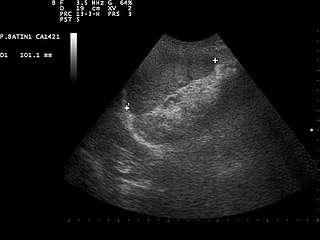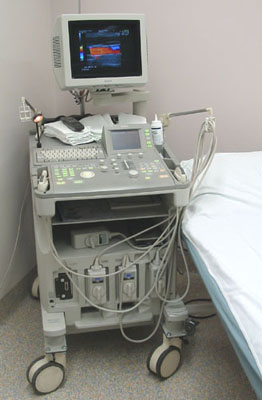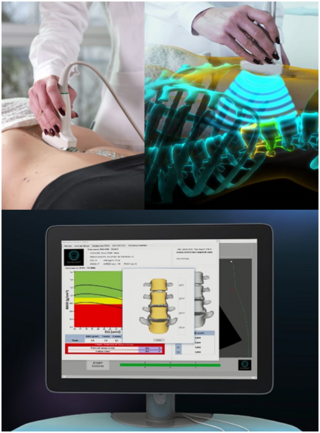Related Research Articles

Medical ultrasound includes diagnostic techniques using ultrasound, as well as therapeutic applications of ultrasound. In diagnosis, it is used to create an image of internal body structures such as tendons, muscles, joints, blood vessels, and internal organs, to measure some characteristics or to generate an informative audible sound. The usage of ultrasound to produce visual images for medicine is called medical ultrasonography or simply sonography, or echography. The practice of examining pregnant women using ultrasound is called obstetric ultrasonography, and was an early development of clinical ultrasonography. The machine used is called an ultrasound machine, a sonograph or an echograph. The visual image formed using this technique is called an ultrasonogram, a sonogram or an echogram.

The human shoulder is made up of three bones: the clavicle (collarbone), the scapula, and the humerus as well as associated muscles, ligaments and tendons.

In human anatomy, the metacarpal bones or metacarpus, also known as the "palm bones", are the appendicular bones that form the intermediate part of the hand between the phalanges (fingers) and the carpal bones, which articulate with the forearm. The metacarpal bones are homologous to the metatarsal bones in the foot.

Penile fracture is rupture of one or both of the tunica albuginea, the fibrous coverings that envelop the penis's corpora cavernosa. It is caused by rapid blunt force to an erect penis, usually during vaginal intercourse, or aggressive masturbation. It sometimes also involves partial or complete rupture of the urethra or injury to the dorsal nerves, veins and arteries.

A joint dislocation, also called luxation, occurs when there is an abnormal separation in the joint, where two or more bones meet. A partial dislocation is referred to as a subluxation. Dislocations are often caused by sudden trauma on the joint like an impact or fall. A joint dislocation can cause damage to the surrounding ligaments, tendons, muscles, and nerves. Dislocations can occur in any major joint or minor joint. The most common joint dislocation is a shoulder dislocation.

Gynecologic ultrasonography or gynecologic sonography refers to the application of medical ultrasonography to the female pelvic organs as well as the bladder, the adnexa, and the recto-uterine pouch. The procedure may lead to other medically relevant findings in the pelvis.This technique is useful to detect myomas or mullerian malformations.

Nonunion is permanent failure of healing following a broken bone unless intervention is performed. A fracture with nonunion generally forms a structural resemblance to a fibrous joint, and is therefore often called a "false joint" or pseudoarthrosis. The diagnosis is generally made when there is no healing between two sets of medical imaging, such as X-ray or CT scan. This is generally after 6–8 months.

The subscapularis is a large triangular muscle which fills the subscapular fossa and inserts into the lesser tubercle of the humerus and the front of the capsule of the shoulder-joint.

Osteochondritis dissecans is a joint disorder primarily of the subchondral bone in which cracks form in the articular cartilage and the underlying subchondral bone. OCD usually causes pain during and after sports. In later stages of the disorder there will be swelling of the affected joint which catches and locks during movement. Physical examination in the early stages does only show pain as symptom, in later stages there could be an effusion, tenderness, and a crackling sound with joint movement.

Focused assessment with sonography in trauma is a rapid bedside ultrasound examination performed by surgeons, emergency physicians, and paramedics as a screening test for blood around the heart or abdominal organs (hemoperitoneum) after trauma. There is also the extended FAST (eFAST) which includes some additional ultrasound views to assess for pneumothorax.

Transient synovitis of hip is a self-limiting condition in which there is an inflammation of the inner lining of the capsule of the hip joint. The term irritable hip refers to the syndrome of acute hip pain, joint stiffness, limp or non-weightbearing, indicative of an underlying condition such as transient synovitis or orthopedic infections. In everyday clinical practice however, irritable hip is commonly used as a synonym for transient synovitis. It should not be confused with sciatica, a condition describing hip and lower back pain much more common to adults than transient synovitis but with similar signs and symptoms.

Subacromial bursitis is a condition caused by inflammation of the bursa that separates the superior surface of the supraspinatus tendon from the overlying coraco-acromial ligament, acromion, and coracoid and from the deep surface of the deltoid muscle. The subacromial bursa helps the motion of the supraspinatus tendon of the rotator cuff in activities such as overhead work.

Abdominal ultrasonography is a form of medical ultrasonography to visualise abdominal anatomical structures. It uses transmission and reflection of ultrasound waves to visualise internal organs through the abdominal wall. For this reason, the procedure is also called a transabdominal ultrasound, in contrast to endoscopic ultrasound, the latter combining ultrasound with endoscopy through visualize internal structures from within hollow organs.

A humerus fracture is a break of the humerus bone in the upper arm. Symptoms may include pain, swelling, and bruising. There may be a decreased ability to move the arm and the person may present holding their elbow. Complications may include injury to an artery or nerve, and compartment syndrome.
Emergency ultrasound employing point-of-care ultrasound (POCUS) is the application of ultrasound at the point of care to make immediate patient-care decisions. It is performed by the health care professional caring for the injured or ill persons. This point-of-care use of ultrasound is often to evaluate an emergency medical condition, in settings such as an emergency department, critical care unit, ambulance, or combat zone.

A supracondylar humerus fracture is a fracture of the distal humerus just above the elbow joint. The fracture is usually transverse or oblique and above the medial and lateral condyles and epicondyles. This fracture pattern is relatively rare in adults, but is the most common type of elbow fracture in children. In children, many of these fractures are non-displaced and can be treated with casting. Some are angulated or displaced and are best treated with surgery. In children, most of these fractures can be treated effectively with expectation for full recovery. Some of these injuries can be complicated by poor healing or by associated blood vessel or nerve injuries with serious complications.

Fertility testing is the process by which fertility is assessed, both generally and also to find the "fertile window" in the menstrual cycle. General health affects fertility, and STI testing is an important related field.
Prehospital ultrasound is the specialized application of ultrasound by paramedics, to guide immediate care and treatment procedures. Like conventional ultrasound, it is a device that produces cyclic sound pressure to penetrate a medium (flesh) and reveal details about the inner structure of the medium.

Pain in the hip is the experience of pain in the muscles or joints in the hip/ pelvic region, a condition commonly arising from any of a number of factors. Sometimes it is closely associated with lower back pain.

Radiofrequency Echographic Multi Spectrometry (REMS) is a non-ionizing technology for osteoporosis diagnosis and for fracture risk assessment. REMS processes the raw, unfiltered ultrasound signals acquired during an echographic scan of the axial sites, femur and spine. The analysis is performed in the frequency domain. Bone mineral density (BMD) is estimated by comparing the results against reference models.
References
- ↑ Ingo Marzi: "Verletzungsformen" In: Kindertraumatologie Springer, Berlin/Heidelberg 2010. ISBN 978-3-642-00990-7, p 12.
- ↑ Peter Hallscheidt, Axel Haferkamp: „Niere" In: Urogenitale Bildgebung. Springer, Berlin/Heidelberg 2010. ISBN 978-3-642-10526-5, p 24.
- ↑ Kolja Eckert et al: Sonographische Frakturdiagnostik. In: Der Radiologe 55, 2015, pp 992–999; ISSN 0033-832X
- ↑ Ole Ackermann et al: Indikationen zur sonographischen Frakturdiagnostik von Frakturen im Wachstumsalter. In: Trauma Berufskrankh 17, 2015, pp 115–121; ISSN 1436-6274
- ↑ P Heller: "Schall schlägt Strahlen" In: Frankfurter Allgemeine Sonntagszeitung 10.2.2013, 2013, p 61; ISSN 0174-4909
- ↑ Harald Lutz: Physikalische Grundlagen. In: Ultraschallfibel Innere Medizin. Springer, Berlin/Heidelberg 2007. ISBN 978-3-540-29320-0, pp 1–8.
- ↑ Joshi et al: "Diagnostic Accuracy of History, Physical Examination, and Bedside Ultrasound for Diagnosis of Extremity Fractures in the Emergency Department: A Systematic Review". In: ACADEMIC EMERGENCY MEDICINE 20(1), 2013, pp 1–15 ISSN 1069-6563
- ↑ Dieter Weitzel et al.: Bewegungsapparat. In: Pädiatrische Ultraschalldiagnostik. Springer, Berlin/Heidelberg 1984. ISBN 978-3-642-69336-6, pp 226–230.
- ↑ JD Moritz et al: Kann Ultraschall das Röntgen in der pädiatrischen Frakturdiagnostik ersetzen? In: Ultraschall in Med. 30, 2009, V3_01; ISSN 0172-4614
- ↑ Francis A. Duck, A.C Baker, H.C Starritt: Ultrasound in Medicine. CRC Press 1998. ISBN 978-1-420-05037-0
- ↑ A. Brunner, W. Lang: Sonographische Diagnostik. In: Thomas Noppeney, Helmut Nüllen (Hrsg.): Diagnostik und Therapie der Varikose. Springer, 2010, ISBN 978-3-642-05366-5, pp 93–100.
- ↑ Ole Ackermann et al: Sonographische Diagnostik von metaphysären Wulstbrüchen. In: Der Unfallchirurg. 112, 2009, pp 706–711; ISSN 0177-5537
- ↑ Hennecke et al: Sonografische und röntgenologische Quantifizierung der Palmarabkippung von subkapitalen Frakturen der Metakarpalia IV und V. In: Handchirurgie· Mikrochirurgie· Plastische Chirurgie. 43, 2011, pp 39–45, ISSN 0722-1819.
- 1 2 Ole Ackermann, Kolja Eckert: Sonographische Frakturdiagnostik im Kindesalter. In: Rupprecht (Hrsg) Pädiatrische Ultraschalldiagnostik. Ecomed-Verlag, Landsberg. 31. Ergänzungslieferung. 2014 ISBN 978-3-609-71602-2
- 1 2 3 Kolja Eckert, Ole Ackermann: Fraktursonographie im Kindesalter. CME Fortbildung. In: Der Unfallchirurg 117, 2014, pp 355-368. ISSN 0177-5537
- ↑ Ole Ackermann et al: Ist die Sonographie geeignet zur Primärdiagnostik kindlicher Vorderarmfrakturen? In: Deutsche Zeitschrift für Sportmedizin. 60, 2009, pp 355–358, ISSN 0344-5925.
- ↑ Rabiner et al: Accuracy of point-of-care ultrasonography for diagnosis of elbow fractures in children. In: Annals of Emergency Medicine 61, 2013, pp 9–17 ISSN 0196-0644
- 1 2 Kolja Eckert et al.: Accuracy of the sonographic Fat Pad Sign for primary screening of pediatric elbow fractures: a preliminary study. In: Journal of Medical Ultrasonics 41, 2014, pp 473–480. ISSN 1346-4523
- ↑ Ole Ackermann et al: Sonographische Diagnostik der subcapitalen Humerusfraktur im Wachstumsalter. In: Der Unfallchirurg. 113, 2010, pp 83––844, ISSN 0177-5537.
- ↑ Klitscher, Weinberg: Klavikula. In: Tscherne : Unfallchirurgie. Springer, Berlin/Heidelberg 2014, ISBN 978-3-642-63754-4, pp 175–188.
- ↑ Annelie-Martina Weinberg, Harald Tscherne: "Klavikula" in: Unfallchirurgie im Kindesalter Teil 1. Springer Verlag 2006. ISBN 978-3-540-36006-3
- ↑ Truong et al: Stellenwert der Sonographie in der Diagnostic der Diverticulitis. In: Diverticulitis. Springer, Berlin/Heidelberg 2001, ISBN 978-3-642-59493-9, pp 169–175.
- ↑ Chaar-Alvarez et al: Bedside ultrasound diagnosis of nonangulated distal forearm fractures in the pediatric emergency department. In: Pediatric Emergency Care. 27 (11), 2011, pp 1027–1032. ISSN 0749-5161
- ↑ Leitgeb: A new noninvasive quantitative method for fracture diagnosis. In: Medical progress through technology. 11, 1986, pp 185–190. ISSN 0047-6552